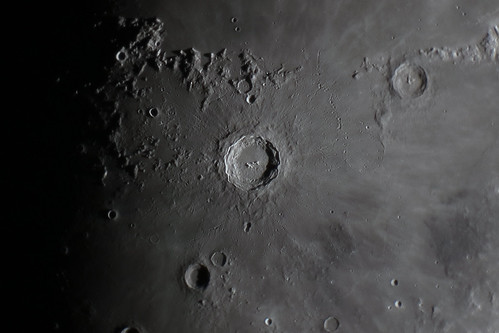23 February, 20:00 – 21:30
Sky transparency not as good as on the 10th. Heavy condensation curtailed the session after 90 minutes.
M44, Beehive Cluster in Cancer
Not surprisingly, too large for the field at 50x (24mm Panoptic), but still an attractive sight. Lots of bright stars arranged in twos and threes.
M67, open cluster in Cancer
Lovely sight at 50x; a “filmy” mass of stars which appears richer than it probably is due to the lower contrast. Bright star nearby (to north), which looks like it's trailing the rest of the cluster in its wake.
NGC 2392 (Eskimo Nebula), planetary nebula in Gemini
At 240x (Nagler 5mm), unfiltered, the central star was clearly visible, but with both filters it was overwhelmed by the surrounding nebulosity. Very bright in the OIII (a little more so than the Ultrablock). No structure seen other than the concentric rings (which showed up best at 133x).
NGC 2371-2, planetary nebula in Gemini
Small and faint (more so than the previous viewing). The OIII at 240x seemed to “fill in” the nebula: very faint nebulosity completing the circle. Western lobe brighter, with central knot or condensation.
NGC 2355, open cluster in Gemini
Large, fairly loose cluster – not particularly rich in stars, but still distinctive enough to be pretty. Brightest members form a leaf shape, with a stalk of fainter stars curling north to a bright field star. This cluster doesn’t appear to have a nickname so feel free to call it the “Leaf Cluster” (until O’Meara names it the “Hershey Kiss Cluster” or something similar in his next book!).
M42, Great Nebula in Orion
On the wrong side of the meridian now, but still a majestic sight. Seeing variable, but E and F stars in the Trapezium were occasionally visible at 240x. Lots of intricate dark structure even at this high magnification. The Trapezium seemed to reside in a dark “hollow” within the Huygens region, but this may well be an illusory effect caused by my eyes re-adjusting to the brightness of the stars.
Rigel was a fairly easy split at 240x despite poor seeing.
Castor split nicely at 240x. About a magnitude difference between the pair.
Subsequent observations at 133x (Nagler 9mm).
NGC 2903, galaxy in Leo
Not as good as the last time I saw it, but just a suggestion of spiral arms in an s-shape.
NGC 2683, galaxy in Lynx
Long, bright spindle. Dark lane on northern edge?
Gamma Leonis (Algieba)
Nice split (albeit tight) at 133x. Subtle colour variation (orange and yellow?); needs another look.
With the condensation building, I grabbed a quick look at the following objects (a preview of forthcoming attractions, so to speak):
M63 (Sunflower Galaxy) in Canes Venatici
Bright, finely mottled appearance.
M94, galaxy in Canes Venatici
Bright, suggestion of dark lane.
M106, galaxy in Canes Venatici
Quite large and bright – may well be bright enough to show structure on a better night. Oddly, this is the first time I’ve seen this galaxy. For some reason I always managed to overlook it with the 4-inch (even though I'm sure it would have been easily visible).
Cor Caroli
Double star, wider separation than the other doubles I looked at tonight.
Nature Note
Three frogs in the pond (two mating).

